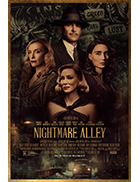Nightmare Alley (2021)
|  Although the title would seem to suggest otherwise, Nightmare Alley is Guillermo del Toro’s first non-supernatural film, although it is no less horrific. It is just as haunted and filled with monstrosities as his previous films, beginning with his auspicious debut, the modern vampire fable Cronos (1993), except this time all the monsters are human and the hauntings come from the weight they carry from their past sins. This has, in a way, always been del Toro’s territory, as his supernatural entities are usually less terrifying than his bestial human characters, notably Sergi López’s fascistic Spanish officer in Pan’s Labyrinth (2006) and Michael Shannon’s Cold War security expert in the Oscar-winning The Shape of Water (2016). In del Toro’s worlds, the worst atrocities are not the stuff of supernatural creep-outs, but rather human beings who have lost sight of their humanity. Based on the 1946 novel by William Lindsay Gresham, which was previously adapted to the screen in 1947 at the height of the film noir era by Edmund Goulding with Tyronne Power and Joan Blondell, Nightmare Alley takes place in two distinctly different worlds, both of which are equally beset with duplicity and treachery. The first half of the film unfolds within the world of the itinerate carnival, which is populated by swindlers, cheats, freaks, and geeks—the latter of which is the literal name applied to the poor denizen of the carnival’s most grotesque attraction, whose job is to bite the heads off live chickens. Into this world comes Stanton Carlisle (Bradley Cooper), who we see in the film’s opening scene dragging a body and dumping it under the floorboards of a ramshackle house that he then sets on the fire. The identity of the corpse and the circumstances surrounding his death are gradually revealed as the film progresses, but suffice it say that this opening establishes Stanton as a dangerous character who is capable of many, many things. The carnival turns out to be a natural fit for him, as he is drawn in by the proprietor, Clem Hoatley (Willem Dafoe), a scurrilous man of few—if any—scruples who recognizes the profit potential of simple exploitation. Although he first works as a barker, Stanton soon ingratiates himself with Zeena (Toni Collette), the resident tarot reader and mentalist who is an excellent practioner of a finely tuned art of duplicity that involves verbal signals from her husband, Pete (David Strathairn), a seasoned con man slowly being consumed by alcoholism. Stanton also meets Molly Cahill (Rooney Mara), a sweet-natured performer who does an act in which bolts of electricity are shot through her body. Molly and Pete and Zeena represent the sympathetic outsiders so common in del Toro’s films, although Nightmare Alley focuses more on how those on the margins of society must often resort to brutality—physical and emotional—to survive. Stanton starts to learn the tricks of the trade and discovers that he is a natural grifter who is at his best when convincing people he knows things he shouldn’t. He and Molly plot to leave the carnival for a more lucrative life—as he puts it, “same tricks, different threads.” Honing their mentalism act, he and Molly become major attractions for high-end audiences in Buffalo, where they play to ballrooms filled with tuxedoed and gown-clad couples who are just as willing to suspend disbelief as the poor yokels at the carnival. Stanton, always looking for the next rung on the ladder, becomes involved with Dr. Lilith Ritter (Cate Blanchett), a calculating psychoanalyst who partners with him to supply private information about her patients that he can then use yto inform his ruse. He also starts to move away from mentalism and into the realm of the so-called “spook show,” where he purports to commune with people’s dead loved ones via séance. This is what brings him into the sphere of his most ambitious mark, a brutal tycoon named Ezra Grindle (Richard Jenkins), who wants to commune with a loved one who died a horrible death decades earlier because of something he did. Grindle is an awful man, but also one who is burdened by genuine guilt, which is why he is willing, despite his skepticism, to believe in Stanton’s professed powers. “Don’t do the spook show,” Zeena warns him, but the warning goes unheeded, thus setting Stanton up for a particularly brutal demise in which his carefully laid plans spin rapidly and violently out of his control. Unlike most of del Toro’s films, Nightmare Alley does not provide us with a sympathetic protagonist with whom we can easily identify and side through the nightmares. Cooper plays Stanton as unapologetically selfish and manipulative and quite possibly murderous, and if we find ourselves still rooting for him in some sense, it is because he is surrounded by people who are arguably worse, whether it be Willem Dafoe’s Clem, who gleefully explains how he enslaves desperate addicts into chicken-biting geeks, or Richard Jenkins’s scowling Ezra Grindle (what a name!), who admits to hurting young women as a means of coping with his own loss, or Cate Blanchett’s chilly Dr. Ritter, whose cold eyes and calculating air makes her a particularly ruthless femme fatale. We sense, despite the terrible things he does, that Stanton is, at heart, a loser, and whatever he manages to achieve is fleeting. When he is at the height of his success as a mentalist, living with the woman he supposedly loves in a high-end hotel and eating room service and wearing tailor-made clothes, he is a far cry from the homeless vagabond we met at the beginning of the film, but his apparent triumph still feels ill-fitting, and it isn’t long before he starts the unravelling of his own existence by pushing beyond his own limits. If we like Stanton at all, it is perhaps because he seems the most alive to possibility, while most of the characters around him are fixed in their amoral lives, whether high or low. Del Toro and cinematographer Dan Laustsen, who shot Mimic (1997), his first Hollywood film, and his two most recent films, Crimson Peak (2015) and The Shape of Water, give Nightmare Alley a surreal visual elegance. The film is a study in contrasting spaces—the sweat and mud and grime of the opening passages at the rural carnival are a far cry from the sleek, elegant, spotless art-deco interiors of the second half—but it is all treated with the same intensely physical palpability. Light and shadow are managed with both grit and poetry, and the intense colors make you feel like you are back in the three-strip Technicolor era (a version of the film played in limited engagements in black and white, but I can’t image a worse choice). The characters are, in many ways, extensions of the spaces they inhabit, which is what makes Dr. Ritter’s elegantly appointed office so menacing and the ramshackle carnival tents and shacks so intensely claustrophobic. Like all great film noir, Nightmare Alley is a film about entrapment, about characters charting their own amoral paths and paying the price for it in the end. And, while the 1947 version tacked on a dubious, potentially happy ending, del Toro and co-screenwriter Kim Morgan offer no such illusions, following Gresham’s novel to the bleakest of conclusions that is equal parts poetic justice and existential gut-punch. Copyright © 2022 James Kendrick Thoughts? E-mail James Kendrick All images copyright © Warner Bros. |
Overall Rating: 


 (3.5)
(3.5)


